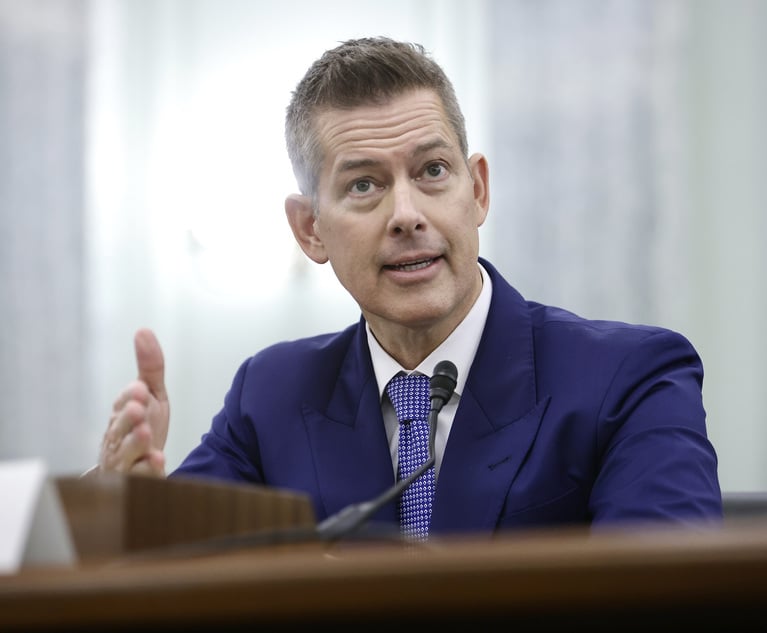The Heat Is On: How Law Firms Should Respond to the Increased Calls for Diversity from Clients: Part Two
Part one of this series focused on how law firms can meet the increasing diversity and inclusion expectations of their clients by recognizing that improving…
September 13, 2017 at 02:06 AM
10 minute read
The original version of this story was published on Law.com
Part one of this series focused on how law firms can meet the increasing diversity and inclusion expectations of their clients by recognizing that improving diversity and inclusion is an organizational issue, assessing how the structures within the firm can suppress diversity rather than foster it, and holding leaders accountable for failing to meet the diversity goals of the firm. The series continues with further exploration into organizational strategies to help firms address calls for improved diversity.
Invest in long-term strategies
It is not uncommon that a crisis, exodus or other wake-up moment precipitates change. We must resist implementing quick solutions that end up short-changing long-term strategies to embed inclusion into our practices and culture. Quick fixes and measures to have quick results are not bad. For example, consider my efforts to be healthy: I am cutting the amount of carbohydrates I am ingesting, and I am also increasing my exercise and behaviors during the work day from movement to packing my lunch. My efforts include short-term investments and long-term strategies that involve commitment, planning, and new habits. Similarly, short term + long term + consistency + education + accountability = the diversity and inclusion results we want. We can hire laterals to increase diversity, but we must address our culture and leadership to keep those laterals. We can create a bold goal of increasing diversity hiring by 50 percent, for example, but we must invest in development programs to invest and develop these attorneys and support them effectively to success. We must have a plan that goes beyond now. We can send everyone to implicit bias training but we must follow up with organizational changes to promote new behaviors, measure changes, incentivize and provide tools for individual behavior change, and tweak our systems as needed to create consistently new results.
It starts with leaders—and not just their speech
The billable culture, focus on business development and traditions behind old-school lawyer development impact diversity and inclusion in real and practical ways. People don't stay at their jobs because the Diversity & Inclusion Committee launched a fantastic initiative—they stay when they are engaged and belong. Engagement requires that we equip, invest in, respect and value our diverse talent. The job of the D&I committee and firm leaders is to focus on implementing systemic change, educating to raise awareness, equipping leaders to lead diverse and cross-cultural teams, and providing solutions that engage a diverse workforce. How people feel day to day, however, is impacted by whether they have access to opportunities, whether their talents are leveraged, if they have a voice on their teams, if they feel respected and included by colleagues, and if their leaders show cultural competence. There are all critical components of creating belonging for diverse talent. For this reason, I frequently ask that we stop talking about retention; instead, we should talk about engagement and advancement. Our talented professionals are not passive receptacles waiting to be kept in an organization, retained but unseen and undervalued. People want their strengths and abilities leveraged, to be part of healthy and competitive high-performing teams, and to belong. Engagement is the difference between a thriving career and one where you are waiting to escape. Diversity and inclusion efforts should then include supporting leaders in their development and growth as effective, inclusive leaders.
What this means, then, is that we must spend more time looking beyond the education we provide on diversity and inclusion. Implicit bias training will create awareness, and leaders interrupting bias or behaving better will make a difference in the experiences of team members. Cultural intelligence competency training will educate leaders on why team members may behave the way they do, but culturally competent processes and behavior will make space for different ways of showing the same skill and not being penalized. As the leader goes, so goes the team. It is imperative, then, that we emphasize the role that leaders play and pay attention to their behavior. Leaders should be evaluated based on their commitment and participation in inclusion initiatives as well as whether they model inclusion competencies. Organizations should reward those who are inclusive and behave in ways consistent with the culture the organization is seeking to create.
As I end this point, it is important to note that I believe most people want to do the right thing. I have never hosted a diversity and inclusion program at my firm where two things haven't happened: 1) several people say everyone should be required to attend the seminar; and 2) people respond positively to my request to pick one to three things to work on to change their behavior or implement what they have learned. Include in your education programs an opportunity for people to identify action items they can begin to implement right away, and then follow up with them on how they are doing and if they need help. This process helps individuals follow through with their commitments better than just going to a session and walking out.
Do the analysis, follow the data
It is tempting to send a headline about a flashy new initiative at another law firm or corporation to your head diversity and inclusion professional to ask if your firm should institute it. Don't. Each initiative and program at your organization should have a concrete, holistic strategy behind it, and that strategy should be linked to the needs of the organization. What does your data tell you—quantitative and qualitative? What are the experiences of your talent? To find out, do a climate survey, host focus groups and conduct interviews—talk to people about why they stay at the organization, what contributed to their success, and whether they can identify the reasons they have struggled. Review metrics and data from multiple viewpoints, and slice the data to parse the information. After you've gathered and assessed your data, carefully craft your initiatives to meet those needs and offer narrowly tailored solutions to the problems at hand. Bottom line: resist the impulse to focus on output over impact or follow the headlines and buzz instead of conducting a thorough internal assessment and considering your core priorities and strategic approach or plan. If you read about a firm implementing an attention-getting diversity initiative, understand that the initiative should be part of a broader strategy and analyze whether you think it will help your firm meet the needs of its diverse talent.
Customize the solutions—one size doesn't fit all
With limited time and resources, you may be tempted to craft programs and require everyone to participate in them. But while many underrepresented groups share some experiences, those experiences are often distinct. The myth of inclusion is that if you are inclusive you must include everyone in everything. Sometimes the solution for one group is only effective and meaningful if restricted to that group. In addition, failing to recognize the differences between groups (and intersectionality, for that matter) leads to crafting one-size solutions that may work for many women, but not for women of color or minorities, for example. For a number of years, Shook has offered a Diversity Retreat exclusively for minority and LGBT attorneys. After each retreat, I get a deluge of questions on why others could not attend. It is humbling that others want to benefit from the content of our Diversity Retreats, but I stand firm (with the support of my firm's leaders) that the retreat is only for minority and LGBT attorneys. Shook offers an amazing array of programs, opportunities and initiatives that are open to everyone. We can stand to sometimes let our underrepresented professionals focus on their own needs and create a safe space to discuss their unique challenges as minorities.
We must also pay attention to intersectionality. One flaw of previous feminist movements and women's initiatives in many organizations, for example, has been the failure to address intersectionality. The topic on its own could be a book and certainly its own article. The point, though, is that we must pay attention to the many ways intersectionality shows up when crafting programs and initiatives. Race impacts the experiences of women, as does being LGBT or differently abled. We must ensure that our women's initiatives address all women. We must also have the courage and wisdom to say no to making programs all-inclusive if the driving need for the program or initiative is not all-inclusive.
That said, in most instances, an inclusive approach serves the organization better by bringing in those from the underrepresented group and allies, creating a circle of belonging that emphasizes that are all needed and should be involved. It is critically important to include white men in the strategic planning, communication and implementation of diversity and inclusion initiatives. Allies and others in the organization also must be educated on inclusion challenges within the organization. But we must be mindful of when specific initiatives created to give a safe space for people from underrepresented groups to discuss and navigate challenges unique to them are vulnerable to being co-opted.
Conclusion
We can develop organizations that have diverse, high-performing teams delivering excellent results for a changing world. Getting there requires an intentional strategy as well as consistent, patient and bold leaders. We must be ready and willing to help our time-constrained partners and leaders find innovative, practical and effective ways to be more inclusive. It also requires execution because having a great strategy is only the start; we need people in the organization who take responsibility for effective implementation. The demands for diversity from clients and the ABA are an invitation to make the legal community welcoming to every qualified person who seeks to join it, and now is the time for us to commit to making a difference. Taking the time to step back and evaluate our efforts to be sure we address organizational and structural barriers is well worth our time. Implement a process to:
- Commit to having organizational solutions based on organizational causation;
- Analyze how your culture contributes to the problem;
- Question the level of accountability and make changes accordingly;
- Invest in long term strategies;
- Make Diversity & Inclusion a leadership issue and responsibility;
- Follow the data; and
- Customize solutions to address the need raised and the challenge to be resolved.
After all, it really is all about Inclusion.
Kori S. Carew is Shook, Hardy & Bacon's Director of Strategic Diversity Initiatives. In this leadership role, she equips and empowers leaders to interrupt bias and manage diverse teams inclusively, crafts solutions designed to disrupt systems and achieve equitable results, and equips diverse talent for success. Kori integrates her experience as a trial attorney and law firm partner into the firm's diversity and inclusion strategies.
This content has been archived. It is available through our partners, LexisNexis® and Bloomberg Law.
To view this content, please continue to their sites.
Not a Lexis Subscriber?
Subscribe Now
Not a Bloomberg Law Subscriber?
Subscribe Now
NOT FOR REPRINT
© 2025 ALM Global, LLC, All Rights Reserved. Request academic re-use from www.copyright.com. All other uses, submit a request to [email protected]. For more information visit Asset & Logo Licensing.
You Might Like
View All


After Botched Landing of United Airlines Boeing 767, Unlikely Plaintiff Sues Carrier
5 minute read
DOT Moves to Roll Back Emissions Rules, Eliminate DEI Programs
Trending Stories
- 1Two More Victims Alleged in New Sean Combs Sex Trafficking Indictment
- 2Jackson Lewis Leaders Discuss Firms Innovator Efforts, From Prompt-a-Thons to Gen AI Pilots
- 3Trump's DOJ Files Lawsuit Seeking to Block $14B Tech Merger
- 4'No Retributive Actions,' Kash Patel Pledges if Confirmed to FBI
- 5Justice Department Sues to Block $14 Billion Juniper Buyout by Hewlett Packard Enterprise
Who Got The Work
J. Brugh Lower of Gibbons has entered an appearance for industrial equipment supplier Devco Corporation in a pending trademark infringement lawsuit. The suit, accusing the defendant of selling knock-off Graco products, was filed Dec. 18 in New Jersey District Court by Rivkin Radler on behalf of Graco Inc. and Graco Minnesota. The case, assigned to U.S. District Judge Zahid N. Quraishi, is 3:24-cv-11294, Graco Inc. et al v. Devco Corporation.
Who Got The Work
Rebecca Maller-Stein and Kent A. Yalowitz of Arnold & Porter Kaye Scholer have entered their appearances for Hanaco Venture Capital and its executives, Lior Prosor and David Frankel, in a pending securities lawsuit. The action, filed on Dec. 24 in New York Southern District Court by Zell, Aron & Co. on behalf of Goldeneye Advisors, accuses the defendants of negligently and fraudulently managing the plaintiff's $1 million investment. The case, assigned to U.S. District Judge Vernon S. Broderick, is 1:24-cv-09918, Goldeneye Advisors, LLC v. Hanaco Venture Capital, Ltd. et al.
Who Got The Work
Attorneys from A&O Shearman has stepped in as defense counsel for Toronto-Dominion Bank and other defendants in a pending securities class action. The suit, filed Dec. 11 in New York Southern District Court by Bleichmar Fonti & Auld, accuses the defendants of concealing the bank's 'pervasive' deficiencies in regards to its compliance with the Bank Secrecy Act and the quality of its anti-money laundering controls. The case, assigned to U.S. District Judge Arun Subramanian, is 1:24-cv-09445, Gonzalez v. The Toronto-Dominion Bank et al.
Who Got The Work
Crown Castle International, a Pennsylvania company providing shared communications infrastructure, has turned to Luke D. Wolf of Gordon Rees Scully Mansukhani to fend off a pending breach-of-contract lawsuit. The court action, filed Nov. 25 in Michigan Eastern District Court by Hooper Hathaway PC on behalf of The Town Residences LLC, accuses Crown Castle of failing to transfer approximately $30,000 in utility payments from T-Mobile in breach of a roof-top lease and assignment agreement. The case, assigned to U.S. District Judge Susan K. Declercq, is 2:24-cv-13131, The Town Residences LLC v. T-Mobile US, Inc. et al.
Who Got The Work
Wilfred P. Coronato and Daniel M. Schwartz of McCarter & English have stepped in as defense counsel to Electrolux Home Products Inc. in a pending product liability lawsuit. The court action, filed Nov. 26 in New York Eastern District Court by Poulos Lopiccolo PC and Nagel Rice LLP on behalf of David Stern, alleges that the defendant's refrigerators’ drawers and shelving repeatedly break and fall apart within months after purchase. The case, assigned to U.S. District Judge Joan M. Azrack, is 2:24-cv-08204, Stern v. Electrolux Home Products, Inc.
Featured Firms
Law Offices of Gary Martin Hays & Associates, P.C.
(470) 294-1674
Law Offices of Mark E. Salomone
(857) 444-6468
Smith & Hassler
(713) 739-1250






